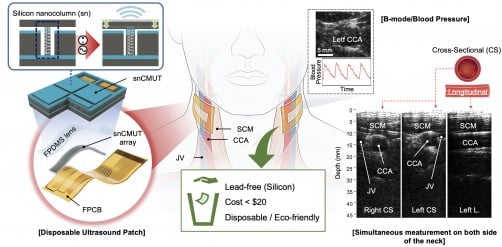A team of researchers has developed a groundbreaking silicon-based ultrasound patch that enhances medical imaging while being environmentally friendly. Led by Dr. Byung Chul Lee at the Korea Institute of Science and Technology (KIST) and in collaboration with experts from KAIST, Seoul National University Hospital, and Stanford University, this innovation addresses the health and environmental concerns associated with conventional lead-based ultrasound devices.
Currently, many wearable ultrasound devices rely on lead (Pb)-based piezoelectric ceramics, which pose risks to human health and the environment. The new silicon ultrasound patch is a significant advancement, promising high performance without the use of lead. The research team has successfully fabricated an ultrathin patch, measuring only a few hundred micrometers in thickness, utilizing semiconductor technology to create a nanocolumn structure.
By eliminating the traditional matching and backing layers, which are essential components in standard ultrasound transducers, the team has maintained stable performance while achieving a flexible and thin design. As a result, the new patch offers improved output and image quality, effectively removing the reliance on lead altogether.
In practical tests, the silicon patch demonstrated over 30% higher output pressure compared to commercial transducers, leading to significantly enhanced image quality. It also reliably measured vital parameters, such as blood flow velocity and vessel diameter, especially in dynamic areas like the neck. Accuracy levels reached over 96% when compared to clinical blood pressure monitors, highlighting its viability for real-world medical applications.
The researchers anticipate that this innovative technology could play a crucial role in telemedicine and personalized healthcare devices. The silicon-based ultrasound transducer, produced through semiconductor processes, enables low-cost, large-scale manufacturing while posing less environmental harm post-use. The estimated production cost is approximately 1/20 that of traditional lead-based devices, making it not only economically viable but also eco-friendly.
Moving forward, the research team plans to validate the patch’s safety and reliability in various clinical environments. They envision expanding its applications to a wide array of medical fields, including early diagnosis of cardiovascular diseases, rehabilitation monitoring, and mental health management.
Dr. Byung Chul Lee stated, “This research is highly meaningful in that we successfully developed an ultrasound patch that anyone can use safely by replacing harmful lead with silicon.” In a similar vein, Prof. Whal Lee from Seoul National University Hospital remarked on the flexibility of silicon-based devices, noting, “Compared to piezoelectric transducer-based devices, silicon-based ultrasound devices can be manufactured in diverse forms, significantly broadening the range of medical applications for ultrasound imaging.”
The findings of this research were published in the recent issue of the international journal Nature Communications, which has an impact factor of 15.7 and ranks among the top journals in its field. This work was supported by the Ministry of Science and ICT through KIST’s Major Program and the Korea Medical Device Development Fund.
As healthcare continues to evolve, this advancement in ultrasound technology signals a promising step toward safer, more efficient medical practices.
